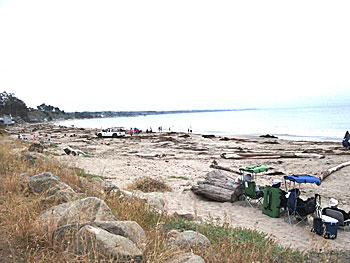New Brighton State Beach & Pacific Migrations Visitor Center
By Edita McQuary

From the 1850’s to the 1880’s, it was known as China Beach, or China Cove. There was a small village constructed of scrap lumber and driftwood erected at the base of the cliffs. A plaque at the beach entrance reads “it was established by Chinese fishermen who set their nets by boat and then hauled their daily catch onto the beach by hand for drying and selling. By l890, however, the expanding resort industry and waves of anti-Chinese sentiment had combined to force the last of the Chinese fishermen out of Santa Cruz County.”
The beach is a bit narrow and strewn with bunches of seaweed and logs weathered by sea and wind – good places to sit and look at the ocean. There are metal-encased fire pit circles every twenty or so feet that were being used by families enjoying their Sunday afternoon BBQ. The rest rooms nearby appear newly built.
There was no sign of, or to, the Visitor Center so we asked a park ranger. He guided us back up to where the entrance road split into “Camping” and “Beach.” We drove up the meandering tree-lined “Camping” road and came upon the lovely Spanish-style building nestled in a grove of towering trees. Inside were poster board displays of the Ohlone Indian life, Spanish colonial/mission time, Mexican cattle culture under Mexican land grants (ranchos) and the American settlement.
After the Mexican-American War ended in 1847, more American immigrants arrived and married into the established Mexican families. One of these immigrants was Thomas Fallon, son-in-law of Martina Castro, owner of the Rancho Soquel land grant, who deeded a part of her property to Thomas. He turned it into a resort he named Camp San Jose, hoping to attract visitors from San Jose. When that didn’t work too well, he re-named it New Brighton after the English seaside resort.
A large wall map shows the Pacific migration paths of various creatures: birds (Sooty Shearwaters), grey whales, and Monarch butterflies. The Kuroshio Current, (“Black Tide”), flows northeast of the coast of Japan into the north Pacific and down the western coast of North America. It influences weather, sea life, and the migratory pattern of many animals. The equivalent of the North Atlantic’s “Gulf Stream,” it transports warm tropical water northward toward the polar region. The rich assortment of nutrients it carries feeds a diverse assortment of migratory fauna on their long migrations.
Most of us know about the Monarch butterfly and grey whale migrations. But the Sooty Shearwater is an entirely different story. In 1961 an article in the local paper reported that a large migratory flock of this species angrily attacked the Santa Cruz area. Movie director Alfred Hitchcock lived in Scotts Valley at the time and heard about this incident. This article and a short story by Daphne du Maurier about unusual bird behavior was the inspiration for his 1963 film, “The Birds.” Later, scientists discovered it was likely toxic algae coming out of leaky septic tanks installed in the early 1960’s during a Monterey Bay housing boom had poisoned the birds.
The campsites are located above the Visitor Center spread out among many trees and shrubs and while the space is open, there is a sense of privacy between each campsite. There is just enough space between sites promoting neighborliness but not so little that one is forced into it. Options are always good – some people want peace and quiet – some want to socialize.
This family-friendly state park has a lot to offer with 100+ camping spaces (including four with wheelchair accessibility), seven rest rooms with showers at the campsites, a small gathering place or amphitheater, an interesting Visitor Center, and a beautiful beach — all in our own backyard!
•••